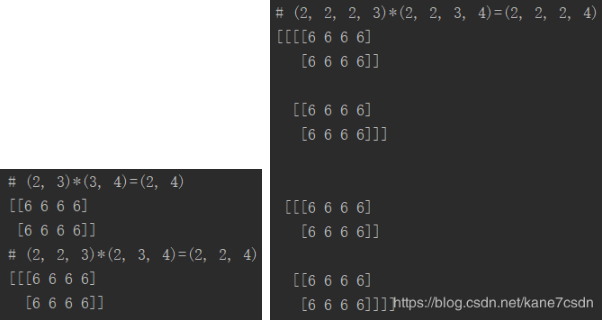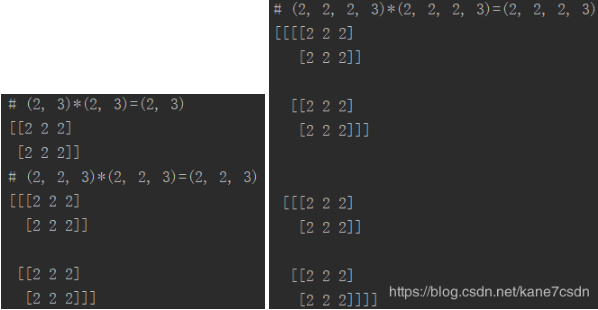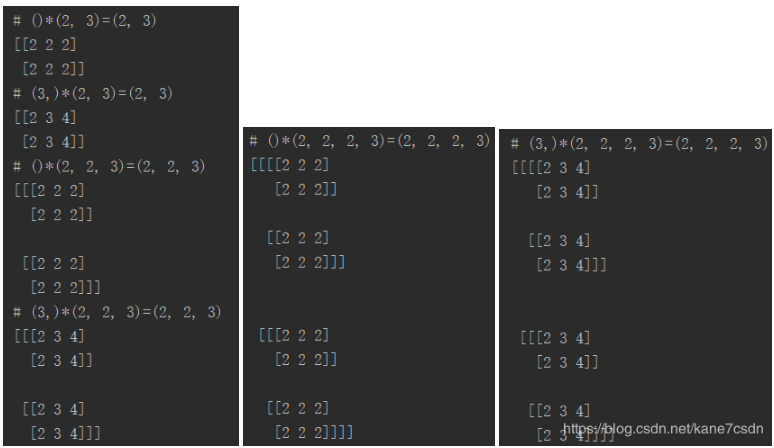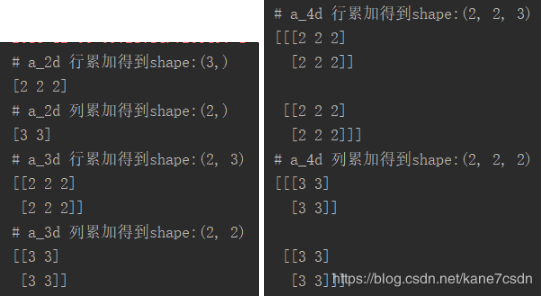Tensorflow二维、三维、四维矩阵运算(矩阵相乘,点乘,行/列累加)
1. 矩阵相乘 
根据矩阵相乘的匹配原则,左乘矩阵的列数要等于右乘矩阵的行数。
在多维(三维、四维)矩阵的相乘中,需要最后两维满足匹配原则。
可以将多维矩阵理解成:(矩阵排列,矩阵),即后两维为矩阵,前面的维度为矩阵的排列。
比如对于(2,2,4)来说,视为2个(2,4)矩阵。
对于(2,2,2,4)来说,视为2*2个(2,4)矩阵。
import tensorflow as tf
a_2d = tf.constant([1]*6, shape=[2, 3])
b_2d = tf.constant([2]*12, shape=[3, 4])
c_2d = tf.matmul(a_2d, b_2d)
a_3d = tf.constant([1]*12, shape=[2, 2, 3])
b_3d = tf.constant([2]*24, shape=[2, 3, 4])
c_3d = tf.matmul(a_3d, b_3d)
a_4d = tf.constant([1]*24, shape=[2, 2, 2, 3])
b_4d = tf.constant([2]*48, shape=[2, 2, 3, 4])
c_4d = tf.matmul(a_4d, b_4d)
with tf.Session() as sess:
tf.global_variables_initializer().run()
print("# {}*{}={} \n{}".
format(a_2d.eval().shape, b_2d.eval().shape, c_2d.eval().shape, c_2d.eval()))
print("# {}*{}={} \n{}".
format(a_3d.eval().shape, b_3d.eval().shape, c_3d.eval().shape, c_3d.eval()))
print("# {}*{}={} \n{}".
format(a_4d.eval().shape, b_4d.eval().shape, c_4d.eval().shape, c_4d.eval()))

2. 点乘 
点乘指的是shape相同的两个矩阵,对应位置元素相乘,得到一个新的shape相同的矩阵。
a_2d = tf.constant([1]*6, shape=[2, 3])
b_2d = tf.constant([2]*6, shape=[2, 3])
c_2d = tf.multiply(a_2d, b_2d)
a_3d = tf.constant([1]*12, shape=[2, 2, 3])
b_3d = tf.constant([2]*12, shape=[2, 2, 3])
c_3d = tf.multiply(a_3d, b_3d)
a_4d = tf.constant([1]*24, shape=[2, 2, 2, 3])
b_4d = tf.constant([2]*24, shape=[2, 2, 2, 3])
c_4d = tf.multiply(a_4d, b_4d)
with tf.Session() as sess:
tf.global_variables_initializer().run()
print("# {}*{}={} \n{}".
format(a_2d.eval().shape, b_2d.eval().shape, c_2d.eval().shape, c_2d.eval()))
print("# {}*{}={} \n{}".
format(a_3d.eval().shape, b_3d.eval().shape, c_3d.eval().shape, c_3d.eval()))
print("# {}*{}={} \n{}".
format(a_4d.eval().shape, b_4d.eval().shape, c_4d.eval().shape, c_4d.eval()))

另外,点乘的其中一方可以是一个常数,也可以是一个和矩阵行向量等长(即列数)的向量。
即 
因为在点乘过程中,会自动将常数或者向量进行扩维。
a_2d = tf.constant([1]*6, shape=[2, 3])
k = tf.constant(2)
l = tf.constant([2, 3, 4])
b_2d_1 = tf.multiply(k, a_2d) # tf.multiply(a_2d, k) is also ok
b_2d_2 = tf.multiply(l, a_2d) # tf.multiply(a_2d, l) is also ok
a_3d = tf.constant([1]*12, shape=[2, 2, 3])
b_3d_1 = tf.multiply(k, a_3d) # tf.multiply(a_3d, k) is also ok
b_3d_2 = tf.multiply(l, a_3d) # tf.multiply(a_3d, l) is also ok
a_4d = tf.constant([1]*24, shape=[2, 2, 2, 3])
b_4d_1 = tf.multiply(k, a_4d) # tf.multiply(a_4d, k) is also ok
b_4d_2 = tf.multiply(l, a_4d) # tf.multiply(a_4d, l) is also ok
with tf.Session() as sess:
tf.global_variables_initializer().run()
print("# {}*{}={} \n{}".
format(k.eval().shape, a_2d.eval().shape, b_2d_1.eval().shape, b_2d_1.eval()))
print("# {}*{}={} \n{}".
format(l.eval().shape, a_2d.eval().shape, b_2d_2.eval().shape, b_2d_2.eval()))
print("# {}*{}={} \n{}".
format(k.eval().shape, a_3d.eval().shape, b_3d_1.eval().shape, b_3d_1.eval()))
print("# {}*{}={} \n{}".
format(l.eval().shape, a_3d.eval().shape, b_3d_2.eval().shape, b_3d_2.eval()))
print("# {}*{}={} \n{}".
format(k.eval().shape, a_4d.eval().shape, b_4d_1.eval().shape, b_4d_1.eval()))
print("# {}*{}={} \n{}".
format(l.eval().shape, a_4d.eval().shape, b_4d_2.eval().shape, b_4d_2.eval()))

4. 行/列累加
a_2d = tf.constant([1]*6, shape=[2, 3])
d_2d_1 = tf.reduce_sum(a_2d, axis=0)
d_2d_2 = tf.reduce_sum(a_2d, axis=1)
a_3d = tf.constant([1]*12, shape=[2, 2, 3])
d_3d_1 = tf.reduce_sum(a_3d, axis=1)
d_3d_2 = tf.reduce_sum(a_3d, axis=2)
a_4d = tf.constant([1]*24, shape=[2, 2, 2, 3])
d_4d_1 = tf.reduce_sum(a_4d, axis=2)
d_4d_2 = tf.reduce_sum(a_4d, axis=3)
with tf.Session() as sess:
tf.global_variables_initializer().run()
print("# a_2d 行累加得到shape:{}\n{}".format(d_2d_1.eval().shape, d_2d_1.eval()))
print("# a_2d 列累加得到shape:{}\n{}".format(d_2d_2.eval().shape, d_2d_2.eval()))
print("# a_3d 行累加得到shape:{}\n{}".format(d_3d_1.eval().shape, d_3d_1.eval()))
print("# a_3d 列累加得到shape:{}\n{}".format(d_3d_2.eval().shape, d_3d_2.eval()))
print("# a_4d 行累加得到shape:{}\n{}".format(d_4d_1.eval().shape, d_4d_1.eval()))
print("# a_4d 列累加得到shape:{}\n{}".format(d_4d_2.eval().shape, d_4d_2.eval()))

以上这篇Tensorflow矩阵运算实例(矩阵相乘,点乘,行/列累加)就是小编分享给大家的全部内容了,希望能给大家一个参考,也希望大家多多支持。